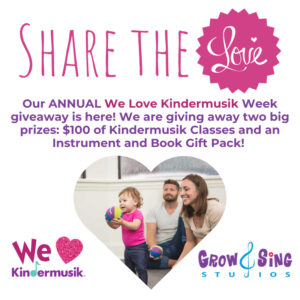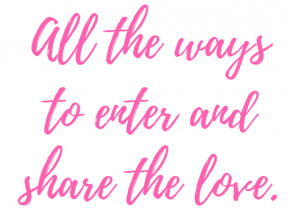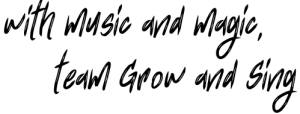News
🎶 21 Summers of Music, Joy, and Connection at Grow and Sing Studios
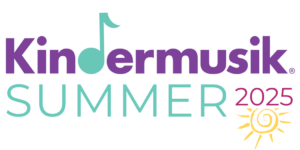 Can you believe it? It’s our 21st summer of bringing music, movement, and joy to families across Central Florida! At Grow and Sing Studios, summer isn’t just a season—it’s a magical time to connect, play, and grow through music.
Can you believe it? It’s our 21st summer of bringing music, movement, and joy to families across Central Florida! At Grow and Sing Studios, summer isn’t just a season—it’s a magical time to connect, play, and grow through music.
Whether you’re looking for music classes for babies in Orlando, or fun mommy and me music experiences in Oviedo, UCF, Orlando, Winter Garden, Lake Nona, Winter Park, or beyond—our Kindermusik Summer session is the perfect way to keep the learning going while making memories that last.
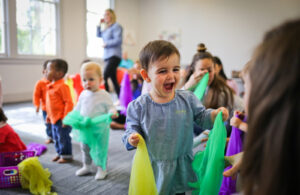
☀️ What’s New This Summer?
We’re excited to offer two amazing Kindermusik themes for our 2025 summer session:
👶 For Babies: Kindermusik Busy Days
Who says babies have it easy? This delightful unit explores the rhythms of daily life—errands, playdates, and all the little adventures in between! In Busy Days, you’ll bond with your baby through movement, music, instrument play, and activities that focus on social and emotional development.
🧒 For Toddlers & Preschoolers (Mixed Age): Kindermusik Splash!
Splish! Splash! Just add water and stir! This wet and wild unit is full of sensory fun as your child explores the music and movement of boats, baths, beaches, and bubbles. It’s the perfect summer activity for toddlers and preschoolers in Orlando who love to move, sing, and get silly.
🎵 What’s Included in Summer Classes?
Your summer tuition includes:
- 6 weekly Kindermusik classes
- Digital music downloads to enjoy at home or on the go
- A physical storybook that complements our theme
- A colorful movement scarf for creative play
- Classes are offered in a relaxed and welcoming environment, perfect for first-timers or Kindermusik regulars. It’s a great way to enjoy music education in early childhood while making meaningful connections—with both your child and a community of other families.
🧳 Traveling This Summer? No Problem!
We know that summer often brings vacations and schedule shifts. That’s why we offer a pro-rate option for up to 2 missed classes, available at the time of registration.
👉 Families must register for at least 4 classes to take advantage of this option. If you’re planning travel, simply select the pro-rate option during registration. (Please note: after registration, refunds aren’t available for the summer session.)
📍 Serving Central Florida Families
We proudly offer Kindermusik classes in Orlando, Lake Nona, Baldwin Park, Winter Park, Winter Garden, Oviedo and Lake Mary/Sanford and surrounding areas. No matter where you’re located, there’s a Grow and Sing Studios class near you (or perhaps will be soon!)
🎟️ Ready to Explore Summer Class Options?
Whether you’re searching for baby music classes, toddler music classes in Orlando, or fun and educational mommy and me summer classes, we’d love to welcome your family this summer!
👉 View our full summer schedule and register here.
Here’s to 21 Summers of Growing and Singing Together
Thank you for letting us be part of your family’s journey. We can’t wait to celebrate another summer filled with music, laughter, learning, and love.
With gratitude,
Holly and the Grow and Sing Studios Team
📣 Don’t Forget to Share!
If you know a fellow parent looking for music for their baby or toddler this summer, pass this along! Our classes fill quickly, and we’d love to share the joy of music with more families in our community. 🎶
Enter to win $100 of KINDERMUSIK CLASSES and an INSTRUMENT/PROP GIFT PACK!
It’s time for Kindermusik International’s annual “We Love Kindermusik” week ALL around the world. Kindermusik is enjoyed by so many, and once again we can all share our experiences and love for this amazing enrichment program together.
“WE LOVE KINDERMUSIK” week is truly intended to be a week of happy reminders of why we all love Kindermusik and most importantly, of all the special people – educators, families, and children – who come together every week to change the world through music…. one child and one song at a time.
Read below for details on how to share the love, and enter to win one of our exciting prizes! We are giving away $100 worth of CLASSES AT GROW AND SING STUDIOS and also an INSTRUMENT AND PROP GIFT PACK.
We hope you enjoy sharing the love, and good luck! — The Grow and Sing Team
Entries are unlimited so have fun! Here are all the different ways to get an entry into our SHARE THE LOVE GIVEAWAY.
- Color a “We Love Kindermusik” coloring sheet complete including a testimonial of WHY your family loves Kindermusik classes. Not in Kindermusik yet? That’s okay, tell us how you incorporate music at home with your kids. (THIS PART IS REQUIRED FOR ENTRY). Take a photo of your coloring sheet and post to one of our socials (IG, FB, or TIKTOK) or you can even email it to . Be sure it’s set to public so we can see it. Use #growandsing Click here to print coloring sheet.
- Comment on any of our posts, reels or tiktoks and be sure to tag us so we see (each comment is an entry)
- Tag us in a REEL, POST, or STORY. Be sure it is set to public and use tag @growandsingstudios or we may not see it (each tag is an entry)
- If you are a current or past customer of Grow and Sing Studios make our day with a 5 star review on Google! Click here. (5 entries)
FOLLOW US:
FACEBOOK
INSTAGRAM
TIKTOK
We will be keeping close track of entries, and submit your name accordingly. However, you are welcome to email us your entry count as this is very helpful. If you choose to do so, please be sure you let us know exactly how many and WHERE your entries are, so we can verify and get your amount right! Do not send us several emails to verify, just wait until you are done and then send us one complete email listing with all the ways you entered (and how your name appears on social media!). Thank you! The contest begins Monday, February 10, 2025 and will close at 11:59pm Sunday, February 16, 2025. Prizes may be gifted to someone else if you are not able to use it. $100 credit prize can be redeemed for ANY service offered by Grow and Sing Studios including lessons or birthday party. Winners for our giveaway will be chosen by random draw. Winners will be announced sometime during February on our socials once we tally up all the votes, so be sure to like our social media accounts and select get notifications so you don’t miss the announcement of winners.
NO PURCHASE NECESSARY TO ENTER OR WIN. A PURCHASE OF ANY KIND WILL NOT INCREASE YOUR CHANCES OF WINNING. ODDS OF WINNING WILL DEPEND ON THE TOTAL NUMBER OF ENTRIES RECEIVED. VOID WHERE PROHIBITED BY LAW. THIS GIVEAWAY IS NOT ASSOCIATED WITH KINDERMUSIK INTERNATIONAL, FACEBOOK, INSTAGRAM, TIKTOK OR ANY OTHER SOCIAL MEDIA OUTLET.
GOOD LUCK!!!!
Big News: Grow and Sing Studios is Expanding to a New Location!
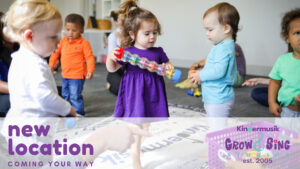 We are beyond excited to share some incredible news with you—Grow and Sing Studios is growing! Starting Friday, February 7, 2025, we are launching Kindermusik classes at a brand-new location: Mindful Music Center in Lake Mary/Sanford. With this addition, we’re now offering School Year Kindermusik classes at 6 amazing locations across Central Florida!
We are beyond excited to share some incredible news with you—Grow and Sing Studios is growing! Starting Friday, February 7, 2025, we are launching Kindermusik classes at a brand-new location: Mindful Music Center in Lake Mary/Sanford. With this addition, we’re now offering School Year Kindermusik classes at 6 amazing locations across Central Florida!
Why Choose Kindermusik with Grow and Sing Studios?
Kindermusik isn’t just about music—it’s about building lasting connections, sparking joy, and supporting your child’s development in a fun and meaningful way. Here are just a few reasons why families love Kindermusik:
- Joyful Learning: Through singing, dancing, instrument play, and storytelling, children thrive in an environment that nurtures their growth.
- Whole-Child Development: Each class is carefully designed to support cognitive, social, emotional, and physical milestones.
- Bonding Moments: Kindermusik is all about YOU and your child connecting through shared musical experiences. Every lullaby, every giggle, every clap becomes a cherished memory.
- Research-Based Excellence: Kindermusik is backed by decades of research into how music can positively impact young minds.
- From newborns to preschoolers, our curriculum grows with your child, offering magical experiences and benefits for every stage of early childhood.
Your Invitation to Experience Kindermusik
If you’ve been considering adding a meaningful activity to your family’s routine, now is the perfect time to give Kindermusik a try.
Secure your spot now: Spaces fill quickly, and we’d love to see you in one of our classes!
Try it for just $5: Not sure if it’s the right fit? Come experience the magic with a $5 preview class. You’ll see firsthand how much your little one lights up in class!
Easy Access: Visit our website growandsing.com for full details, including our updated locations page and how to reserve your space. (Please allow the page a moment to load.)
Got Questions? We’re Here to Help!
Whether you’re curious about class schedules, what to expect, or anything else, we’re just a message away.
Call or Text: 407-970-2774 (If we’re teaching, please leave a voicemail or text, and we’ll get back to you as quickly as possible.)
Email Us: We respond quickly to emails too. You can find our contact info on our website.
What Sets Grow and Sing Studios Apart
At Grow and Sing Studios, we believe in the power of music to transform lives. Every class is more than just an activity—it’s a joyful experience where families can grow, bond, and create memories together. Our mission is to foster connection and learning through music, one family at a time.
We’re thrilled to bring this opportunity to the Lake Mary/Sanford community at Mindful Music Center, and we can’t wait to welcome you and your little one to the Kindermusik family.
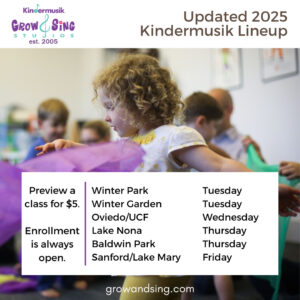 Ready to Join Us?
Ready to Join Us?
Visit growandsing.com to learn more, secure your spot, or sign up for a $5 preview class today. Let’s make magical memories together!
Thank you for being part of the Grow and Sing Studios community. Here’s to music, joy, and meaningful connections—we’ll see you in class soon!
#GrowAndSingStudios #Kindermusik #MusicForKids #BondThroughMusic #BabyClasses #ToddlerClasses #MommyAndMe #LakeMary #SanfordFL #OrlandoFamilies
